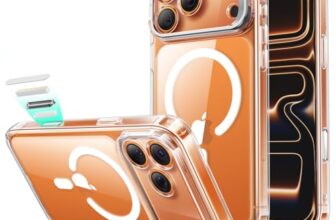Apple AirPods 4 Technical Review: The Apex of Computational Audio and Ergonomic Design
Introduction: The Evolution from Wireless Earbud to Intelligent Audio Companion
In the landscape of personal technology, few products have achieved the cultural and technological ubiquity of Apple’s AirPods. They transformed the wireless earbud from a niche accessory into an essential part of the modern digital experience. With each generation, Apple has pushed the boundaries, moving beyond mere audio playback to create a sophisticated, intelligent, and deeply integrated platform. The arrival of the Apple AirPods 4 marks the most significant leap forward yet for the standard model, inheriting the powerful brain of its “Pro” sibling—the H2 chip—and wrapping it in a completely redesigned form factor that prioritizes all-day comfort and intuitive control. This is not just an incremental update; it is a fundamental re-engineering that brings flagship-level intelligence to the most popular earbud in the world.
The philosophy behind the AirPods 4 is a masterclass in refinement and user-centric design. It addresses the core desires of the everyday user with a singular focus: to create an experience that is as comfortable as it is magical. The all-new, contoured design is the result of extensive ergonomic research, aiming to provide a secure, stable fit that can be worn for hours without fatigue. Powering this new body is the formidable Apple-designed H2 chip, a piece of custom silicon that acts as a computational audio powerhouse. It is the engine that drives a suite of advanced features, including the breathtakingly immersive Personalized Spatial Audio, the crystal-clear call quality of Voice Isolation, and a new layer of hands-free convenience with Siri Interactions. This is a product that promises not just to play your audio, but to place you in the center of it, to make your conversations clearer, and to integrate more seamlessly into your life than ever before. Now updated with a more compact USB-C charging case, it aligns perfectly with the modern Apple ecosystem. And with a limited-time 11% discount, the entry point for this next-generation audio experience is incredibly compelling.
In this exhaustive technical review, we will perform a granular dissection of the technologies that define the AirPods 4. We will analyze the biomechanics of the new ergonomic design, deconstruct the complex algorithms behind the H2 chip’s audio processing, evaluate the real-world performance of its advanced microphone arrays, and explore the “magical” ecosystem integration that continues to set Apple’s audio products apart. This is a deep dive for the discerning user who wants to understand the science behind the seamless experience and discover why the AirPods 4 are poised to redefine the standard for wireless audio once again.

A Deep Dive into the Key Features: A Component-by-Component Technical Analysis
The AirPods 4’s remarkable performance is not derived from a single feature but from the deeply integrated and synergistic operation of its redesigned hardware and advanced H2-powered software. Let’s analyze each core technology from a technical perspective.
-
Ergonomic Science: Rebuilt for All-Day Comfort and Control
The most immediately apparent innovation in the AirPods 4 is their complete physical redesign. This is a ground-up re-engineering focused on two primary goals: improving long-term comfort and enhancing stability for a wider range of ear shapes. The new design features a refined contour that moves away from the one-size-fits-all “universal fit” of previous generations. Based on extensive 3D ear scan data and ergonomic modeling, the new shape is designed to nestle more securely and comfortably within the concha of the ear, distributing its weight more evenly. This reduces pressure on any single point of contact, which is the primary cause of ear fatigue during extended listening sessions. The goal is to create a fit that is so unobtrusive that the user almost forgets they are wearing them.
Complementing the new shape is a noticeably shorter stem. This design choice serves multiple purposes. Aesthetically, it creates a more discreet and streamlined look. Functionally, it reduces the leverage that external forces (like catching on a collar or a scarf) can have on the earbud, contributing to a more stable and secure fit, especially during active use. The shorter stem also houses a new control interface. Apple has moved from the simple tap control to more precise quick-press controls. This force sensor system, similar to that on the AirPods Pro, allows for more deliberate and reliable inputs. A single press can play/pause or answer a call, a double-press skips forward, and a triple-press skips back. This provides a more tactile and error-proof way to manage music or calls without having to reach for your primary device.

-
Psychoacoustic Immersion: The Science of Personalized Spatial Audio
The inclusion of the H2 chip brings one of the most sophisticated audio technologies from the Pro line to the standard AirPods: Personalized Spatial Audio with dynamic head tracking. This feature transforms the standard two-dimensional stereo listening experience into a three-dimensional, cinema-like soundscape. The “Personalized” aspect is the key scientific breakthrough. Our ability to perceive the location of a sound is profoundly influenced by the unique physical geometry of our head and ears. The way sound waves reflect and resonate is unique to each individual, a phenomenon described by a Head-Related Transfer Function (HRTF). Apple leverages the TrueDepth camera system on an iPhone to perform a quick 3D scan of the user’s ear. This biometric data is then used to generate a unique, personal HRTF, which is saved to your Apple ID profile.
When you listen to multi-channel content (like movies encoded in Dolby Atmos or specially mixed music tracks), the H2 chip applies this personal HRTF to the audio signal in real-time, tailoring the 3D audio rendering to your specific anatomy. This dramatically increases the accuracy, realism, and immersiveness of the spatial effect. The experience is further enhanced by dynamic head tracking. The AirPods 4 contain high-precision gyroscopes and accelerometers that track the minute movements of your head relative to your source device (like an iPhone or iPad). As you turn your head to the left, the H2 chip instantly remaps the sound field so that the audio remains “anchored” to the device. This creates the powerful illusion that the sound is emanating from the screen itself, not from the earbuds in your ears, “creating a theater-like listening experience for music, TV shows, movies, games, and more.”

-
Computational Audio Powerhouse: The Apple-Designed H2 Chip and Voice Isolation
The Apple-designed H2 chip is the brain that elevates the AirPods 4 from a simple Bluetooth receiver into a powerful computational audio device. This custom silicon provides a massive increase in processing power over previous generations, enabling a suite of advanced audio algorithms that run in real-time. This is the engine that drives the “Improved Sound and Call Quality.” The H2 works in concert with a custom-built high-excursion driver and amplifier to deliver a richer, more detailed sound. It powers a sophisticated Adaptive EQ. An inward-facing microphone constantly measures the sound pressure inside your ear canal. The H2 chip analyzes this signal and adjusts the low and mid-frequencies of the audio in real-time to compensate for variations in fit, ensuring you get a consistent, high-fidelity sound signature every time you put them in.
One of the most practical applications of the H2’s power is for call quality, specifically through a feature called Voice Isolation. When you are on a phone or FaceTime call in a noisy environment, the AirPods’ dual beamforming microphones work to create a narrow directional “beam” focused on your voice. The H2 chip then applies an advanced machine learning algorithm that has been trained to recognize the characteristics of human speech. It “reduces background noise while isolating and clarifying the sound of your voice for whomever you’re speaking to.” This computational process is so effective that it can dramatically suppress the sound of wind, traffic, or a crowded cafe, making your voice sound crystal clear to the person on the other end of the line.

-
Seamless Integration: The “Magical Experience” of the Apple Ecosystem
The “Magical Experience” is not a single feature but the result of the deep, vertical integration between Apple’s hardware, software, and services. The H2 chip and its associated firmware are the keys to this seamlessness. The initial pairing process is a perfect example. Thanks to the chip’s identification protocols, you simply open the case near your iPhone or iPad, and a prompt to “Connect” appears on your screen—no need to navigate complex Bluetooth menus. Once paired, that connection is shared across all devices logged into your iCloud account, allowing for automatic switching between your iPhone, iPad, Mac, and Apple Watch.
This intelligence extends to the user interface. The always-on listening capability allows you to simply say “Siri” or “Hey Siri” to activate the assistant hands-free. A new, more advanced feature is Siri Interactions. This leverages the motion-detecting accelerometers inside the AirPods. When an incoming notification is announced by Siri, you can simply **nod your head “yes” or shake your head “no”** to have the message read aloud or dismissed, all without speaking a word or touching a device. Other ecosystem features include **Audio Sharing**, which allows you and a friend (with another compatible set of AirPods or Beats) to listen to the same audio stream from a single device. The **optical in-ear sensors** use infrared light to detect when the AirPods are in your ears, automatically playing audio and pausing it the moment you take one out. Finally, the integration with the **Find My app** allows you to see the last known location of your AirPods on a map and play a sound from the case to help you locate them.

-
Enhanced Durability and Power: IP54 Rating and Redesigned USB-C Case
The AirPods 4 are built to be a reliable companion for an active lifestyle. Both the earbuds and the charging case are rated IP54 for dust, sweat, and water resistance. From a technical standards perspective, the ‘5’ in IP54 signifies a high level of protection against dust ingress, while the ‘4’ signifies protection against water splashes from any direction. This means they can easily withstand a heavy workout session, a run in the rain, or exposure to a dusty environment without issue. It’s a crucial durability feature that provides peace of mind for everyday use.
The power system has also been significantly upgraded. The earbuds themselves provide up to 5 hours of listening time on a single charge. The redesigned charging case, which is now **more than 10 percent smaller by volume** than the previous generation, holds multiple additional charges for a total of up to **30 hours of listening time**. This enhanced power efficiency is another direct benefit of the H2 chip. The most significant update to the case is the move to a universal **USB-C charging port**, aligning the AirPods with the rest of the modern tech ecosystem and allowing users to carry a single cable for their iPhone, iPad, Mac, and now, their AirPods. This combination of robust battery life and a more compact, more convenient charging case makes the AirPods 4 an even better travel and all-day companion.

Pros: The Undeniable Technical Strengths
- Vastly Improved Ergonomics and Comfort: The new contoured, shorter-stem design provides a more secure and comfortable fit for a wider range of users, ideal for all-day wear.
- Flagship-Level Computational Audio: The powerful H2 chip enables advanced features like Adaptive EQ and the revolutionary Personalized Spatial Audio, previously exclusive to the Pro model.
- Exceptional Call and Voice Quality: The Voice Isolation feature, powered by beamforming mics and machine learning on the H2 chip, delivers crystal-clear call clarity in noisy environments.
- Deep and Seamless Ecosystem Integration: Effortless pairing, automatic device switching, Audio Sharing, and Find My capabilities create a “magical” and frictionless user experience for Apple users.
- Enhanced Durability and Convenience: The IP54 dust and water resistance for both buds and case, combined with a smaller case and a universal USB-C port, significantly improves real-world usability.
- Intuitive and Advanced Controls: The new quick-press force sensors are more reliable, and the gesture-based Siri Interactions offer a new level of hands-free control.

Cons: Important Technical Considerations and Limitations
- No Active Noise Cancellation (ANC): The most significant differentiator from the Pro model, the standard AirPods 4 do not feature ANC or Transparency Mode, relying solely on their physical shape for passive noise isolation.
- “Universal Fit” Design: Despite the improved ergonomics, the one-size-fits-all, unsealed design will not provide the same level of passive noise isolation or secure fit for intense activities as the Pro model with its customizable silicone tips.
- Ecosystem Dependency: The vast majority of the “magical” and advanced features, including Personalized Spatial Audio and automatic switching, are exclusive to the Apple ecosystem and are not available when paired with Android or Windows devices.
- Limited High-Resolution Audio Support: The AirPods continue to use the AAC Bluetooth codec. They do not support higher-bandwidth codecs like aptX HD or LDAC for streaming higher-resolution audio from compatible services or devices.
- Basic Charging Case: While smaller and now with USB-C, the standard case lacks the wireless charging (MagSafe/Qi) and the U1 chip for Precision Finding found on the Pro model’s case.
Conclusion: The New Gold Standard for Everyday Wireless Audio
The Apple AirPods 4 are a triumph of intelligent refinement and a powerful demonstration of Apple’s vertical integration strategy. By bringing the formidable computational power of the H2 chip to the standard AirPods lineup, Apple has elevated the entire user experience to a new level. The introduction of Personalized Spatial Audio transforms music and movies into truly immersive events, while the dramatic improvements to call quality via Voice Isolation solve a critical real-world problem. These technological leaps are housed in a new body that is a masterclass in ergonomic design, offering a level of comfort and stability that makes the AirPods 4 a genuine all-day companion.
While they intentionally omit the Active Noise Cancellation of their Pro siblings to maintain a clear product differentiation, the features they do possess are executed with a level of polish, intelligence, and seamless integration that is simply unmatched outside of the Apple ecosystem. For the iPhone user, this is a product that feels less like an accessory and more like a natural extension of their device. It is smarter, more comfortable, more durable, and more convenient than its predecessors in every meaningful way. For those who prioritize all-day comfort, exceptional call quality, and the magical, immersive experience of Spatial Audio, the AirPods 4 are not just the best choice; they are the new gold standard for everyday wireless listening.
Frequently Asked Questions (FAQs)
- Q1: What is the main technical difference between the AirPods 4 and the AirPods Pro 2?
- A: The single biggest difference is Active Noise Cancellation (ANC) and Transparency Mode. The AirPods Pro 2 have a sealed in-ear design with silicone tips and use advanced processing to actively cancel outside noise. The AirPods 4 have an open, “universal fit” design and rely only on their physical shape for passive noise isolation. The Pro model also features a more advanced case with wireless charging and Precision Finding.
- Q2: How does the H2 chip in the AirPods 4 technically improve sound quality over the AirPods 3 with the H1 chip?
- A: The H2 chip has significantly more processing power. This allows it to run more complex computational audio algorithms in real-time. The primary benefit is a more sophisticated Adaptive EQ, which better tailors the sound to your ear’s unique shape for a more consistent bass and mid-range response. It also provides the processing headroom for features like Personalized Spatial Audio and improved call clarity via Voice Isolation.
- Q3: Is the “Personalized Spatial Audio” a gimmick, or does it make a real difference?
- A: It makes a real, scientifically measurable difference. It’s based on the principle of Head-Related Transfer Function (HRTF). By scanning your ear’s unique shape with an iPhone’s TrueDepth camera, it creates a custom audio profile. This allows the H2 chip to render 3D audio with a much higher degree of accuracy for your specific anatomy, making the directional effects in movies and music feel significantly more realistic and immersive.
- Q4: Will these AirPods stay in my ears during a workout?
- A: The new contoured design is engineered to be significantly more stable than previous generations for a wider range of ear shapes. For general workouts, jogging, and gym use, most users will find them very secure. However, for extremely high-impact or acrobatic activities, the sealed in-ear design of the AirPods Pro 2 with its silicone tips will always offer a higher level of security.
- Q5: What does the IP54 rating technically mean? Can I shower with them?
- A: No, you should not shower with them. The IP54 rating provides standardized ingress protection levels. The ‘5’ indicates they are “dust protected,” meaning some dust may get in but not enough to interfere with operation. The ‘4’ indicates they are protected against “splashing water” from any direction. This makes them perfectly safe for sweating during exercise or running in the rain, but they are not designed to withstand being submerged or exposed to jets of water.
- Q6: Will I get all the features like Spatial Audio and Siri Interactions if I use the AirPods 4 with my Android phone?
- A: No, you will not. When paired with an Android phone, the AirPods 4 will function as a high-quality standard set of Bluetooth earbuds for listening to music and making calls. You will lose access to all the features that rely on deep integration with Apple’s software and hardware, including Personalized Spatial Audio, automatic device switching, “Hey Siri,” Siri Interactions, and the Find My functionality.
See more posts in the category Headphones.







